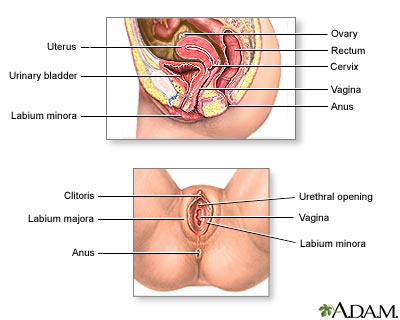Alternate Names : Cervical intraepithelial neoplasia (CIN), Precancerous changes of the cervix
Definition
Cervical dysplasia is the abnormal appearance of cells on the surface of the cervix when they are looked at underneath a microscope. Although this is not cancer, it is considered a precancerous condition.
Dysplasia that is seen on a Pap smear is described using the term squamous intraepithelial lesion (SIL). These changes may be graded as:
- Low-grade (LSIL)
- High-grade (HSIL)
- Possibly cancerous (malignant)
Dysplasia that is seen on a biopsy of the cervix uses the term cervical intraepithelial neoplasia (CIN), and is grouped into three categories:
- CIN I — mild dysplasia
- CIN II — moderate to marked dysplasia
- CIN III — severe dysplasia to carcinoma in situ
Overview, Causes, & Risk Factors
Most cases of cervical dysplasia occur in women ages 25 – 35, although it can develop at any age.
Almost all cases of cervical dysplasia or cervical caner are caused by human papilloma virus (HPV). HPV is a common virus that is spread through sexual contact. There are many different types of HPV. Some types lead to cervical dysplasia or cancer.
The following may increase your risk of cervical dysplasia:
- Becoming sexually active before age 18
- Giving birth before age 16
- Having multiple sexual partners
- Having other illnesses or using medications that suppress your immune system
- Smoking
Pictures & Images
Female reproductive anatomy
External structures of the female reproductive anatomy include the labium minora and majora, the vagina and the clitoris. Internal structures include the uterus, ovaries and cervix.
Cervical neoplasia

Cervical intraepithelial neoplasia (CIN) is the presence of abnormal cells on the surface of the cervix. A Pap smear and colposcopy are two of the procedures performed to monitor the cells and appearance of the cervix.
Uterus

The uterus is a hollow muscular organ located in the female pelvis between the bladder and rectum. The ovaries produce the eggs that travel through the fallopian tubes. Once the egg has left the ovary it can be fertilized and implant itself in the lining of the uterus. The main function of the uterus is to nourish the developing fetus prior to birth.
Cervical dysplasia – series
Normal anatomy

The cervix is the tissue that leads from the uterus into the vagina.
-
Cervical dysplasia : Overview, Causes, & Risk Factors
-
Cervical dysplasia : Symptoms & Signs, Diagnosis & Tests
-
Cervical dysplasia : Treatment



Review Date : 2/21/2010
Reviewed By : Susan Storck, MD, FACOG, Chief, Eastside Department of Obstetrics and Gynecology, Group Health Cooperative of Puget Sound, Redmond, WA; Clinical Teaching Faculty, Department of Obstetrics and Gynecology, University of Washington School of Medicine. Also reviewed by David Zieve, MD, MHA, Medical Director, A.D.A.M., Inc.
